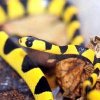Pescaito
Well-Known Member
Asi ya si XD es una Liophis , posiblemente una Liophis poecilogyrus.
Eso si dijiste que tenia 13 subespecies y a mi me salen bastantes ma 48.
Liophis almadensis WAGLER 1824
Liophis amarali WETTSTEIN 1930
Liophis andinus DIXON 1983
Liophis anomalus GÜNTHER 1858
Liophis atraventer DIXON & THOMAS 1985
Liophis breviceps COPE 1861
Liophis carajasensis DA CUNHA, NASCIMENTO & AVILA-PIRES 1985
Liophis ceii DIXON 1991
Liophis cobella LINNAEUS 1758
Liophis cursor LACÉPÈDE 1789
Liophis dilepis COPE 1862
Liophis dorsocorallinus ESQUEDA, NATERA, LA MARCA & ILIJA-FISTAR 2007
Liophis elegantissimus KOSLOWSKY 1896
Liophis epinephelus COPE 1862
Liophis festae PERACCA 1897
Liophis flavifrenatus COPE 1862
Liophis frenatus WERNER 1909
Liophis guentheri PERACCA 1897
Liophis ingeri ROZE 1958
Liophis jaegeri GÜNTHER 1858
Liophis janaleeae DIXON 2000
Liophis juliae COPE 1879
Liophis leucogaster JAN 1863
Liophis lineatus LINNAEUS 1758
Liophis longiventris AMARAL 1925
Liophis maryellenae DIXON 1985
Liophis melanotus SHAW 1802
Liophis meridionalis SCHENKEL 1902
Liophis miliaris LINNAEUS 1758
Liophis ornatus GARMAN 1887
Liophis paucidens HOGE 1953
Liophis perfuscus COPE 1862
Liophis poecilogyrus WIED-NEUWIED 1825
Liophis problematicus MYERS 1986
Liophis reginae LINNAEUS 1758
Liophis sagittifer JAN 1863
Liophis steinbachi BOULENGER 1905
Liophis subocularis BOULENGER 1902
Liophis taeniogaster JAN 1866
Liophis taeniurus TSCHUDI 1845
Liophis torrenicola DONNELLY & MYERS 1991
Liophis trebbaui ROZE 1958
Liophis triscalis LINNAEUS 1758
Liophis typhlus LINNAEUS 1758
Liophis vanzolinii DIXON 1985
Liophis viridis GÜNTHER 1862
Liophis vitti DIXON 2000
Liophis williamsi ROZE 1958
Eso si dijiste que tenia 13 subespecies y a mi me salen bastantes ma 48.
Liophis almadensis WAGLER 1824
Liophis amarali WETTSTEIN 1930
Liophis andinus DIXON 1983
Liophis anomalus GÜNTHER 1858
Liophis atraventer DIXON & THOMAS 1985
Liophis breviceps COPE 1861
Liophis carajasensis DA CUNHA, NASCIMENTO & AVILA-PIRES 1985
Liophis ceii DIXON 1991
Liophis cobella LINNAEUS 1758
Liophis cursor LACÉPÈDE 1789
Liophis dilepis COPE 1862
Liophis dorsocorallinus ESQUEDA, NATERA, LA MARCA & ILIJA-FISTAR 2007
Liophis elegantissimus KOSLOWSKY 1896
Liophis epinephelus COPE 1862
Liophis festae PERACCA 1897
Liophis flavifrenatus COPE 1862
Liophis frenatus WERNER 1909
Liophis guentheri PERACCA 1897
Liophis ingeri ROZE 1958
Liophis jaegeri GÜNTHER 1858
Liophis janaleeae DIXON 2000
Liophis juliae COPE 1879
Liophis leucogaster JAN 1863
Liophis lineatus LINNAEUS 1758
Liophis longiventris AMARAL 1925
Liophis maryellenae DIXON 1985
Liophis melanotus SHAW 1802
Liophis meridionalis SCHENKEL 1902
Liophis miliaris LINNAEUS 1758
Liophis ornatus GARMAN 1887
Liophis paucidens HOGE 1953
Liophis perfuscus COPE 1862
Liophis poecilogyrus WIED-NEUWIED 1825
Liophis problematicus MYERS 1986
Liophis reginae LINNAEUS 1758
Liophis sagittifer JAN 1863
Liophis steinbachi BOULENGER 1905
Liophis subocularis BOULENGER 1902
Liophis taeniogaster JAN 1866
Liophis taeniurus TSCHUDI 1845
Liophis torrenicola DONNELLY & MYERS 1991
Liophis trebbaui ROZE 1958
Liophis triscalis LINNAEUS 1758
Liophis typhlus LINNAEUS 1758
Liophis vanzolinii DIXON 1985
Liophis viridis GÜNTHER 1862
Liophis vitti DIXON 2000
Liophis williamsi ROZE 1958



